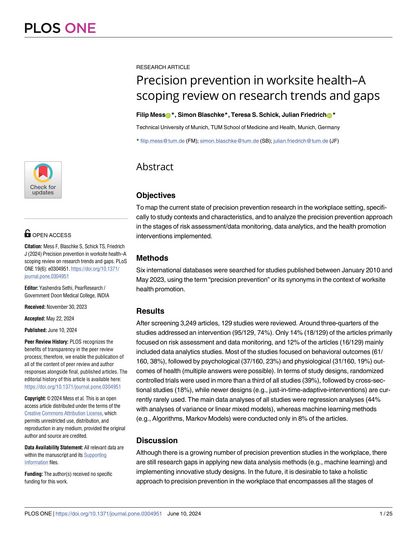Precision prevention uses biological, behavioral, socioeconomic and epidemiological data to develop and implement strategies tailored to, e.g., reducing the incidence and mortality of non-communicable diseases in a specific individual or group of individuals. Despite the relevance of the worksite as an ideal setting for health promotion, precision prevention in the occupational context has not yet been considered comprehensively. In this scoping review, we show, after screening 3,249 articles, that there are currently 129 studies on precision prevention research in the field of occupational health.
The number of studies published annually shows a continuous increase since 2010, with smaller spikes just before the COVID-19 pandemic and then again in 2022. Most of the studies were published in North America (USA and Canada), followed by several European countries (Netherlands, Denmark, United Kingdom) and Australia. Around three-quarters of the studies addressed an intervention (74 %). Only 14 % of the articles primarily focused on risk assessment and data monitoring, and 12 % of the articles mainly included data analytics studies. Most of the studies focused on behavioral outcomes, followed by psychological and physiological outcomes of health. In terms of study designs, randomized controlled trials were used in more than a third of all studies, followed by cross-sectional studies, while newer designs (e.g., just-in-time-adaptive interventions) are currently rarely used.
Although there is a growing number of precision prevention studies in the workplace, there are still research gaps in applying new data analysis methods (e.g., machine learning) and implementing innovative study designs. In the future, it is desirable to take a holistic approach to precision prevention in the workplace that encompasses all the stages of precision prevention (data generation, data analytics, and interventions) and links them together as a cycle. Furthermore, future research on precision prevention should be increasingly implemented in regions and sectors that have been neglected so far to better exploit health potentials in the workplace setting. Based on such a comprehensive understanding of health and a more holistic database of employees, new methods of data analysis could then also be increasingly used. In addition to these recommendations for research, it will also be important for stakeholders from occupational practice and also from politics (health, economy, labor, etc.) to address the possibilities and opportunities of precision prevention in occupational health and to shape this field in the future.
Mess, F., Blaschke, S., Schick, T. S., & Friedrich, J. (2024). Precision prevention in worksite health – A scoping review on research trends and gaps. PLOS ONE, 19(6), e0304951. https://doi.org/10.1371/journal.pone.0304951
